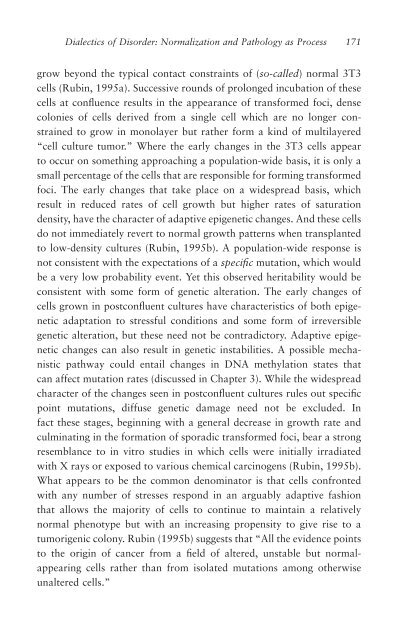A Critique of Pure (Genetic) Information
A Critique of Pure (Genetic) Information
A Critique of Pure (Genetic) Information
Create successful ePaper yourself
Turn your PDF publications into a flip-book with our unique Google optimized e-Paper software.
Dialectics <strong>of</strong> Disorder: Normalization and Pathology as Process 171<br />
grow beyond the typical contact constraints <strong>of</strong> (so-called) normal 3T3<br />
cells (Rubin, 1995a). Successive rounds <strong>of</strong> prolonged incubation <strong>of</strong> these<br />
cells at confluence results in the appearance <strong>of</strong> transformed foci, dense<br />
colonies <strong>of</strong> cells derived from a single cell which are no longer constrained<br />
to grow in monolayer but rather form a kind <strong>of</strong> multilayered<br />
“cell culture tumor.” Where the early changes in the 3T3 cells appear<br />
to occur on something approaching a population-wide basis, it is only a<br />
small percentage <strong>of</strong> the cells that are responsible for forming transformed<br />
foci. The early changes that take place on a widespread basis, which<br />
result in reduced rates <strong>of</strong> cell growth but higher rates <strong>of</strong> saturation<br />
density, have the character <strong>of</strong> adaptive epigenetic changes. And these cells<br />
do not immediately revert to normal growth patterns when transplanted<br />
to low-density cultures (Rubin, 1995b). A population-wide response is<br />
not consistent with the expectations <strong>of</strong> a specific mutation, which would<br />
be a very low probability event. Yet this observed heritability would be<br />
consistent with some form <strong>of</strong> genetic alteration. The early changes <strong>of</strong><br />
cells grown in postconfluent cultures have characteristics <strong>of</strong> both epigenetic<br />
adaptation to stressful conditions and some form <strong>of</strong> irreversible<br />
genetic alteration, but these need not be contradictory. Adaptive epigenetic<br />
changes can also result in genetic instabilities. A possible mechanistic<br />
pathway could entail changes in DNA methylation states that<br />
can affect mutation rates (discussed in Chapter 3). While the widespread<br />
character <strong>of</strong> the changes seen in postconfluent cultures rules out specific<br />
point mutations, diffuse genetic damage need not be excluded. In<br />
fact these stages, beginning with a general decrease in growth rate and<br />
culminating in the formation <strong>of</strong> sporadic transformed foci, bear a strong<br />
resemblance to in vitro studies in which cells were initially irradiated<br />
with X rays or exposed to various chemical carcinogens (Rubin, 1995b).<br />
What appears to be the common denominator is that cells confronted<br />
with any number <strong>of</strong> stresses respond in an arguably adaptive fashion<br />
that allows the majority <strong>of</strong> cells to continue to maintain a relatively<br />
normal phenotype but with an increasing propensity to give rise to a<br />
tumorigenic colony. Rubin (1995b) suggests that “All the evidence points<br />
to the origin <strong>of</strong> cancer from a field <strong>of</strong> altered, unstable but normalappearing<br />
cells rather than from isolated mutations among otherwise<br />
unaltered cells.”
















